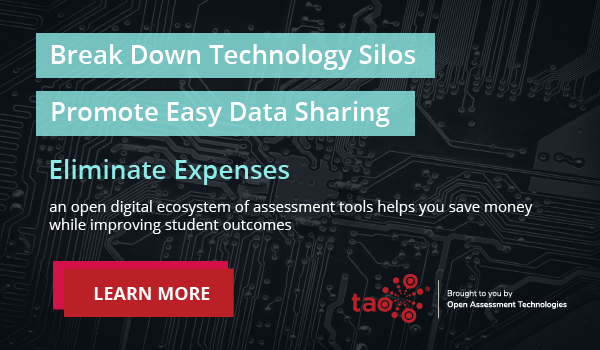Online education is not what it used to be. Though formerly challenged as inferior to in-person instruction, digital learning solutions have evolved tremendously over the last decade. Where these solutions of the past were largely deemed too impersonal, today’s continuous advancement in technology allows instructors to reach a wider range of students and engage them like never before.
For many students, they are experiencing a “digital-first” world. In an attempt to reach them where they are, it’s only natural that the education industry has embraced online learning. Instructors today can leverage digital technology to easily manage and deliver multimedia course content, live stream classes, and deliver assessments that measure complex competencies and behave adaptively. These modern eLearning solutions now extend equal learning opportunities to students who may not be able to attend class in a traditional classroom.
Where online learning is quickly becoming a norm, bringing your courses or assessments online for the first time doesn’t have to be an intimidating task. Below, we break down which digital testing technology and eLearning platform components empower online education and offer a complete digital solution to remote students.
A Streamlined User Experience
A streamlined user experience is perhaps the most critical tech component for empowering both distance learners and digital instructors. There are multiple factors that play into this, including seamless content exchange between systems, scalability, and of course, ease of use. When considering user experience, you want to take into account how your various systems can work together and exchange information, and how their designs visually support different end-users.
Open Standards
To efficiently manage your content and support your students online, it’s important that your different EdTech systems connect with one another and consistently sync information. The QTI and LTI open interoperability standards defined and maintained by IMS Global Learning Consortium ensure that you are able to create a plug-and-play EdTech ecosystem across your institution.
- LTI: The LTI standard allows you to integrate your learning applications with any Learning Management System (LMS) or Student Information System (SIS)
- QTI: The QTI standard allows you to exchange item, test content and results data between different learning and assessment technologies
QTI and LTI compliant solutions enable you to effectively connect assessment to learning and create interactive online learning environments that reflect real-world scenarios. Their open frameworks eliminate data silos, making your student, testing, and other data from various sources more accessible and meaningful.
Student Productivity
These standards additionally help support student productivity – a major concern of many instructors, parents and students themselves when it comes to online education. The LTI standard allows you to provide students access to any number of online tools and applications within a single digital platform. This enables them to see their course content, assessment history and testing results organized in a central hub. In this way, interoperable EdTech offers not only a more engaging and streamlined user experience, but also lowers the total cost of technology ownership for your institution by allowing you to integrate various apps that would normally require separate logins into one system.
For more on interoperability, read our recent post: Interoperability: The Missing Link in EdTech.
Scalability & Security
System crashes are disruptive to test-takers and instructors, imparting a negative user experience. For instance, critical data may be lost if network interruptions occur while a student is working through an online exam. In a high-stakes situation, this type of error could compromise the validity of the results, costing an institution in time, money and resources.
Scalable solutions help mitigate these challenges by leveraging flexible infrastructures that can support a fluctuating number of users. Many universities and districts are now leveraging cloud-based digital testing technologies that are designed to scale to support tens or even hundreds of thousands of learners at a time. In addition to improving user experience, these EdTech solutions enable you to intensify your systems’ security by encrypting data at various levels. They also help you lower your IT costs by reducing hardware and infrastructure overhead.
Easy to Use Interface
The way your EdTech systems and tools are visually designed is also key to a positive user experience. The most effective offer clear user journeys – for both you as an instructor inputting content, and your students consuming it on the other end.
Just because a tool is easy to use does not mean it isn’t powerful. Your EdTech and assessment systems should still have advanced technical capabilities, but their interfaces should be user-friendly and intuitive. For example, you can look for tools with WYSIWYG functionality to help you build content and assessments online, even without advanced technical knowhow. On the student side, the applications they interact with should also follow a clear UX design logic and guide them naturally through their work. As such, consistent interface design also plays a significant role in user accessibility.
Accessibility
Online education is meant to be inclusive, but in order to achieve this, the tech that supports it needs to be accessible. To support a more diverse range of students’ needs, any instruction models that leverage web-based applications must comply with WCAG accessibility standards. Whether you are operating in a flipped classroom or a completely online education program, thinking accessibility-first when it comes to your technology helps you empower a greater number of students of any ability. Read our recent blog post to take a deeper dive into accessibility in EdTech.
Engagement Solutions
Digital testing technology platforms that enable you to create different types of assessment interactions give you the opportunity to engage students authentically online. For example, in a science or math exam, you might want to leverage multi-step PCIs that measure a student’s problem solving process. Or, there may be times when you need to deliver exams that include multimedia clips or simulations along with supporting questions. Even online exam delivery tools like a digital calculator, notepad or highlighter enable your students to engage with your content in a more authentic way. By leveraging interactive testing items that simulate hands-on learning, you can provide greater context to your online exams and improve the experience for remote students.
Security Solutions
Cheating is often a primary concern in online education. Without an instructor proctoring a testing session, it would seemingly be much easier for a student to cheat on an exam. However, digital testing technology is now available to help you monitor and reduce cheating in remote classrooms just as you would in brick-and-mortar. Online exam platforms that integrate with a lockdown browser such as Safe Exam Browser help you create a secure, restricted environment for high-stakes testing. And, if you are leveraging an open technology framework, you can also integrate with high-security proctoring centers and AI-based services to further enforce security.
—
There is no longer a reason to be weary of online education. Engaging students online today is far different than even 10 years ago. With the evolution of interactive technology solutions and standards for developing a secure, streamlined user experience we are now in an era where online education is considered just as effective, and even more inclusive than in-person learning.


